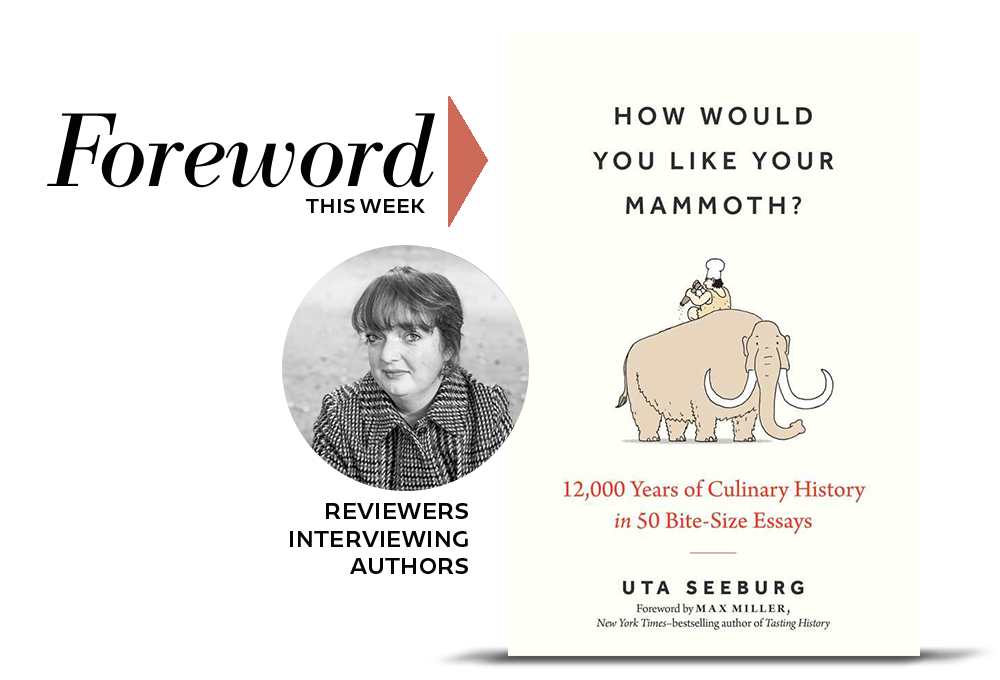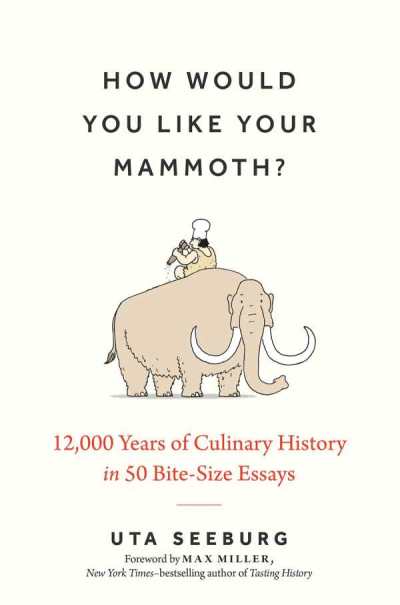Reviewer Interviews Uta Seeburg, Author of How Would You Like Your Mammoth

“Traveling, experiences, and food go hand in hand for me. When I travel, I try to taste everything that is typical of the country I’m visiting. My book is based on this attitude and is intended to invite you to travel through time with a figurative spoon in your hand.’’ —Uta Seeburg

Somewhere in your genetic memory, you have a hankering for mammoth—roasted over an open fire, it was a staple of your ancestral diet for tens of thousands of years. So when those big beasts died off after the last Ice Age ended in 12,000 BCE or so, your kin had to make some dietary adjustments. Archaeological sites around the world show that food and nutrition evolved during this time: big game gave way to smaller game and increasing amounts of seeds, nuts, and berries until approximately 6,000 BCE.
Then came the wild-grass precursors to wheat—einkorn and emmer. Here’s a wonderful story from Maguelonne Toussaint-Samat, author of The History of Food:
The hunter-gatherers, often disappointed by the decreasing amounts of game now available, did not fail to notice that these cereal plants provided a food which was filling and also kept well. In 1966 the American agronomist Jack Harlan carried out an experiment on the slopes of Mount Karacadag, a Turkish volcano, where these wheats still grow spontaneously, in abundance and remarkably true to type. He had only to bend down and gather the first part of his harvest with his bare hands, filling a bag with two and a half kilos of grain in an hour. Then, using a stone sickle, an archaeological relic of some nine thousand years ago, he increased his harvest to almost three kilos. Once it had been threshed and separated from its many husks, the grain weighed only two kilos, but it was of excellent quality. Analysis showed it to have an even higher content of proteins than the best American wheat. A Paleolithic tribe living in these parts, therefore, could have harvested enough grain in three weeks to keep them easily until the next summer.
Let’s not forget the mammoth in the room: Uta Seeburg is here to talk with Karen Rigby, who reviewed Uta’s How Would You Like Your Mammoth? in Foreword’s May/June issue.
How Would You Like Your Mammoth? explores culinary history through ancient civilizations, and also shows us that gathering around the table continues to sustain us. What inspired your curiosity about showing history through people’s relationship to food?
History fascinates me, and I am particularly interested in the everyday experiences of the past. How did people brush their teeth in the 19th century? What did it smell like in ancient Rome? What did an early morning at an Edo-period fish market sound like? These little details bring the past to life, but nothing can tell me more about the desires, the possibilities, and the passions of an era than the food that people loved to eat. My book is based on this idea.
Would you tell us about your journey toward creating this book? Your novels feature an investigator—has exploring foods across time felt a bit similar?
In fact, I often felt like a detective during my research. For thousands of years of human history, there were no proper cookbooks as we know them today. So I had to follow up all kinds of sources and clues and look for witness reports. I also do a lot of research for my historical novels, but this book was an especially tricky case!
Did any discovery surprise or enchant you during your research?
I was very surprised by how political food has always been. In the Middle Ages, for example, a communal meal could function as a binding contract and indicate one’s social status. National dishes are regularly used for propaganda. Since the 19th century, political activists have used hunger strikes to push through their demands. And in Cape Town during apartheid, a particular sandwich came to stand for the community’s resistance.
One of your earlier roles was working for the German edition of Architectural Digest. Has your background in magazine writing informed your approach when it comes to the brief essay? Here, Max Miller’s foreword describes these essays as “snackable.”
Writing for AD has definitely taught me to get to the heart of things, especially in shorter texts. Even back then, I had a great affinity for the culinary arts and was able to write a lot on the subject.
Any favorite gastronomic tidbits, dining experiences, or travel adventures that relate to the places within the book?
I wouldn’t pick out any particular thing, but rather say that traveling, experiences, and food go hand in hand for me. When I travel, I try to taste everything that is typical of the country I’m visiting. My book is based on this attitude and is intended to invite you to travel through time with a figurative spoon in your hand.
Are you fond of cookery outside of writing? Have you replicated or tried any historical recipes before?
I love cooking and baking, although my husband is more of our family’s day-to-day cook. I haven’t cooked any historical recipes, in large part because many of the ingredients are no longer available. And, personally, I don’t really feel like trying mummified ribs, jellyfish soup, or flamingo tongue!
National pride and preserving culture are uniting themes in many of these forays. They’re also motivations that seem to endure, even in ways that may sometimes seem, to some modern readers, nostalgic (as with the “slow food“ movement). How might readers continue to reconnect with their culinary traditions in busy times?
The dishes that make us nostalgic and remind us of our childhood, are often quite simple. Spaghetti with meatballs, apple pie, the soup that grandma used to make. Connecting with our culinary traditions doesn’t take much time, just a little love.
Hospitality, in particular toward strangers, is another strong tie between these essays. Have we been losing that willingness here in the West? If so, why do you think that may be, and what might we do to invite more hospitality into our lives?
The ritual hospitality that I describe taking place in Syria around 850 BCE, for example, may not exist in the West today. But I think that sharing a meal is still absolutely fundamental to our social cohesion. During the pandemic, we dreamed of finally being able to go to restaurants together again, and lockdowns inspired many families to place much more emphasis on eating together. When my daughter makes a new friend at the playground, she shares her sweets with them. Hospitality comes from the heart—it doesn’t have to be complicated.
Who do you envision as the reader for How Would You Like Your Mammoth?
People who like to eat and are curious about what our food says about our history—the good and the bad. And also anyone interested in the origin of bizarre foods: fried swans, meat in tubes, and Hawaiian toast—it’s all here!
Karen Rigby
